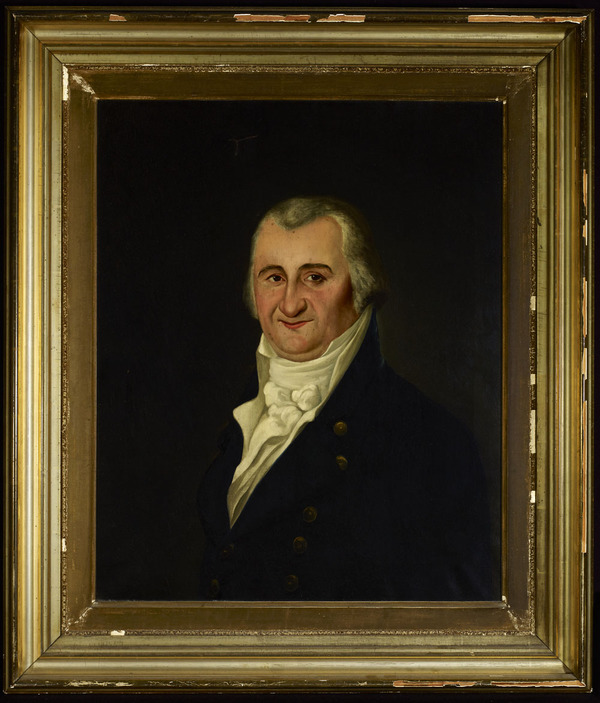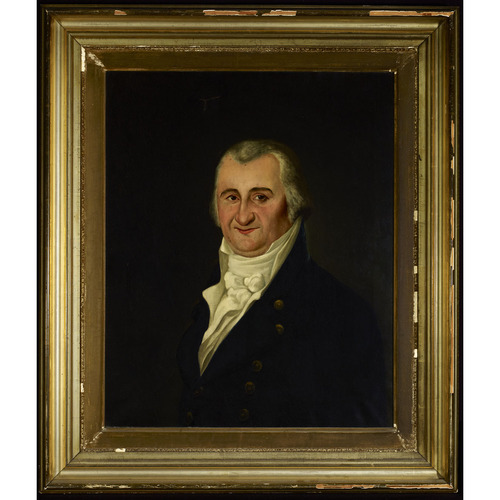BRUNEAU, PIERRE, merchant, politician, and militia officer; b. 22 July 1761 at Quebec, son of Pierre-Guillaume Bruneau, a merchant-furrier, and Marie-Élizabeth Morin, dit Chêneverd; m. there 30 Aug. 1785 Marie-Anne Robitaille, and they had seven children; d. 13 April 1820 in his native town.
Pierre Bruneau spent his childhood at Quebec and at an early age became involved with the trade in fur goods through his father, who had had a shop in Lower Town since at least 1758. Wanting to follow in his father’s footsteps in the business field, he first studied at the Petit Séminaire de Québec from 1771 to 1780. Presumably he learned bookkeeping while subsequently working in his father’s shop, since the management of the latter’s “business in pelts” was entrusted to him in 1786. That year Pierre-Guillaume Bruneau had decided to return to his native town of Poitiers, which he had left in 1754 to come to New France. Pierre quickly expanded the company’s scope, in particular by going into trade in grain, cloth, and spirits. He seems to have been quite prosperous in his business affairs, sufficiently so that in 1791 he could pay 9,000 livres for a big stone house on the Place du Marché (Place Notre-Dame), near the harbour at Quebec, to serve as his residence and as premises for a store of his own.
In 1794 Bruneau was one of those signing the loyalist manifesto, a sort of act of faith in the British authorities in the face of a supposed threat that revolutionary France would stir up popular unrest in the colony. Two years earlier Bruneau had joined the Quebec militia as an ensign. Probably because of his loyalty to the crown the government granted him 400 acres in Nelson Township in 1804. At the same period he opened a second store at Chambly and increased his purchases of grain.
Around 1802, in search of new opportunities for investment, Bruneau had bought two houses on Rue Sainte-Famille and one on Rue Saint-François, which he then rented at £40 to £50. In 1806 one of the houses on Rue Sainte-Famille was converted by the tenant into a hospital for British soldiers. In order to finance his commercial enterprise Bruneau had to resort fairly regularly to loans from British shipowners and rich merchants. In 1807, as a result of overestimating his ability to repay, he found himself in debt to Quebec merchant James Tod for £6,351. To get out of this impasse he promised to sell the three properties on Rue Sainte-Famille and Rue Saint-François and turn over the proceeds to his creditor, and to pay him £250 a year until 1812, failing which all his assets were to be seized. This precarious situation forced Bruneau to consider new solutions for making his firm more profitable. Consequently in April 1807 he hired Charles Labbé, a journeyman muff-maker, who worked at making fur articles under the direction of Mme Bruneau. But seven months later Labbé was imprisoned for defaulting on his contracts; released on bail, he nevertheless went back to work for Bruneau. In any case, the 148 fur hats that Bruneau shipped to Rivière-Ouelle in August 1812 seem to indicate a new burst of activity in his enterprise. Even more revealing is the fact that in 1814 he succeeded in repaying his debt to James Tod. However, he still owed £1,246 to the firm of Brehaut and Sheppard [see Pierre Brehaut], which had supplied him with spirits and other goods.
From 1810 to 1816 Bruneau represented Quebec’s Lower Town in the House of Assembly of Lower Canada. As a member, he sided with the Canadian party, particularly when it was necessary to stand up for the assembly’s privileges. During the War of 1812 he served in the forces defending the colony as major of Quebec’s 2nd Militia Battalion. This detachment assured the defence of Quebec and carried out reconnaissance missions in the surrounding regions. Early in 1816, hostilities with the United States having ended, Bruneau sent his electors a manifesto in which he rejected the principle of judges being eligible to sit on the Legislative Council. This question, which also roused the ire of the Canadian party, brought about the dissolution of the house by Sir George Gordon Drummond*. In the ensuing elections Bruneau was beaten in his riding by François Languedoc*. He tried without success to contest his opponent’s election on grounds of fraud and intimidation. In April 1816 he succeeded, however, in getting elected by acclamation in Kent, which he represented until his death.
Engrossed in his political activity, Bruneau increasingly delegated the management of his business affairs to people competent in the field. Thus on 23 May 1815 he hired William Morin as a clerk at a salary of £60 a year; for his part Morin was to see to the smooth operation of the stores at Quebec and Chambly, concentrating mainly on buying and shipping grain. Three years later Bruneau gave his wife power of attorney to administer his affairs. On 9 April 1820, four days before his death, he bequeathed to her the usufruct of all his property. In 1810 he had already made over to his son René-Olivier the sum of 3,000 livres in the form of an annuity to help him enter holy orders. Of his other children, Julie married Louis-Joseph Papineau* in 1818, and Théophile became a lawyer and Patriote.
Pierre Bruneau was active in the community as a member of the Quebec Fire Society from 1790 to 1820 and as churchwarden of the parish of Notre-Dame from 1807 to 1814. When he died the Quebec Gazette commented appreciatively, “This excellent man brought to trade [and] to private life a courteousness and gentleness of character such that he deservedly never earned any enemies and rightly had many friends.”
ANQ-Q, CE1-1, 30 janv. 1758, 22 juill. 1761, 30 août 1785, 15 avril 1820; CN1-224, 15 juill. 1786; CN1-230, 3 mars 1791, 1er avril 1816, 9 avril 1820; CN1-262, 12 mai 1806; 6 févr., 23 avril 1807; 23 août 1810; 2 août 1812; 19 oct. 1814; 23 avril 1815; 7 juill. 1818. ASQ, Fichier des anciens. Doc. relatifs à l’hist. constitutionnelle, 1791–1818 (Doughty et McArthur; 1915), 492n. “Cahier des témoignages de liberté au mariage commencé le 15 avril 1757,” ANQ Rapport, 1951–53: 39. Quebec Gazette, 10 July 1794; 30 Dec. 1813; 14 March, 4 April 1816; 17 April 1820. Ægidius Fauteux, Patriotes de 1837–1838 (Montréal, 1950), 148. Langelier, Liste de terrains concédés, 600, 1199. Officers of British forces in Canada (Irving), 143. Quebec almanac, 1792–1820. P.-G. Roy, Fils de Québec (4 sér., Lévis, Qué., 1933), 2: 127. Chapais, Cours d’hist. du Canada, 3: 23–24. Henri Têtu, “L’abbé André Doucet, curé de Québec, 1807–1814,”BRH, 13 (1907): 18.
Cite This Article
In Collaboration, “BRUNEAU, PIERRE,” in Dictionary of Canadian Biography, vol. 5, University of Toronto/Université Laval, 2003–, accessed January 20, 2025, https://www.biographi.ca/en/bio/bruneau_pierre_5E.html.
The citation above shows the format for footnotes and endnotes according to the Chicago manual of style (16th edition). Information to be used in other citation formats:
| Permalink: | https://www.biographi.ca/en/bio/bruneau_pierre_5E.html |
| Author of Article: | In Collaboration |
| Title of Article: | BRUNEAU, PIERRE |
| Publication Name: | Dictionary of Canadian Biography, vol. 5 |
| Publisher: | University of Toronto/Université Laval |
| Year of revision: | 1983 |
| Access Date: | January 20, 2025 |




